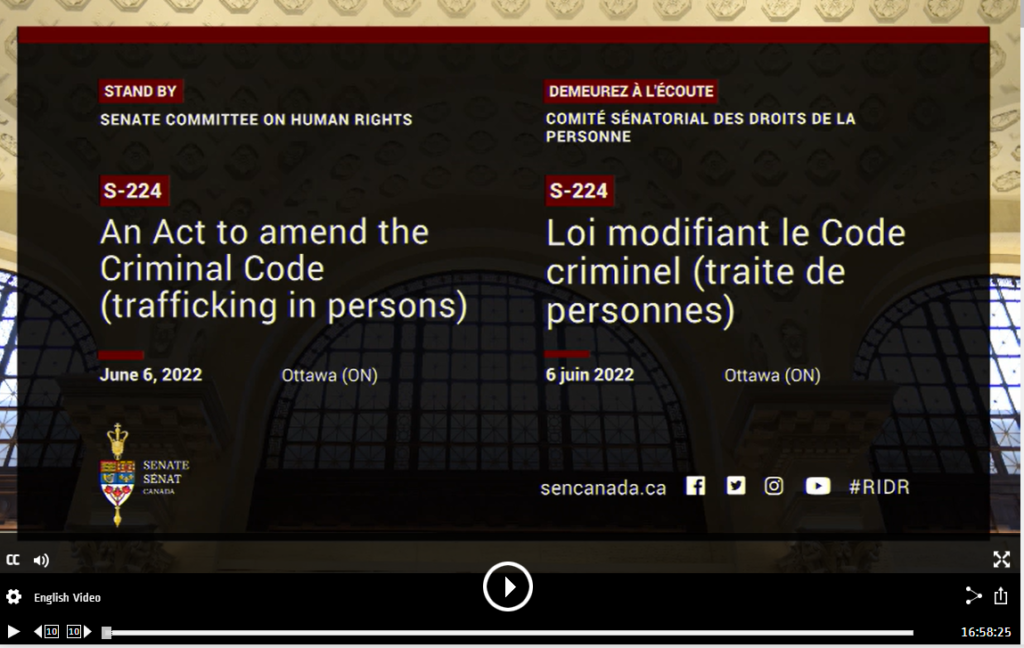On June 6, 2022, Julia Drydyk, Executive Director of the Canadian Centre to End Human Trafficking, testified at the Standing Senate Committee on Human Rights about proposed changes to the Criminal Code of Canada. A provision of the Criminal Code (s.297.04(1)) requires courts to consider whether the circumstances could reasonably cause trafficking victims to “believe that their safety or the safety of a person known to them would be threatened if they failed to provide, or offer to provide, the labour or service.”
The Centre’s research has found that this provision has been inconsistently applied by judges across Canadian court cases. Determining whether someone could have been concerned for their wellbeing – or that of their loved ones – is entirely subjective and vulnerable to biases, interpretations and misconceptions. In fact, its inclusion has resulted in the dismissal of trafficking charges in some cases.
The Canadian Centre to End Human Trafficking supports the removal of the “fear for safety” provision as proposed in Bill S-224, An Act to amend the Criminal Code (trafficking in persons).
Julia Drydyk’s testimony to the Senate Standing Committee, included below, highlights why the Centre has taken this important position:
Testimony of Julia Drydyk, Executive Director, Canadian Centre to End Human Trafficking to the Standing Senate Committee on Human Rights, Senate of Canada (June 6, 2022 – 18:06:07 to 18:11:13):
I’d like to thank members of the committee for having me here today.
The Canadian Centre to End Human Trafficking is a national charity dedicated to ending all types of human trafficking in Canada. We work to mobilize systems change by collaborating and working with various stakeholders to advance best practices, share research and eliminate duplicate efforts across Canada.
In May of 2019, we launched the Canadian Human Trafficking Hotline, a confidential, multilingual service that operates 24-7 to connect victims and survivors with social services and/or law enforcement if they so choose.
The Centre is supportive of Bill S-224 in removing the requirement that the element of fear is necessary to demonstrate to the courts that human trafficking is taking place. This is, in fact, a very overdue change to Canada’s existing Criminal Code definition of human trafficking.
Trafficking charges have been dismissed as recently as 2022 because the courts were unable to prove that the victim feared for their safety or the safety of someone they know, but where obvious and systematic forms of exploitation were taking place directly for the trafficker’s gain and profit. Removing the necessity to prove the element of fear from the Criminal Code definition of human trafficking is far more aligned with addressing the reality of how human trafficking is operating in Canada. It would be a small yet meaningful step in improving access to justice for victims who have experienced sex and labour trafficking in Canada. I say it’s a small step because without mandated and evidence-based training across the judiciary, it’s unlikely that we’ll see the desired outcomes that I believe we would all like to see.
Unfortunately, bias still exists within the judiciary. The stigma that is imposed on individuals in the commercial sex industry, through choice or coercion, continues to present a bias, which is contributing to these incredibly low prosecution rates for traffickers.
As many of you know, certain groups are intentionally targeted by traffickers because their social, physical, economic and basic needs are not being met. As a result, these groups have been overrepresented among those who have experienced trafficking. These groups include Indigenous, Black, racialized and LGTBQI+ communities, as well as those living in poverty and those who are under-housed or precariously housed.
These groups have also historically and are currently experiencing discrimination and abuse from the very institutions that are supposed to protect them. We know that we have work to do to ensure that systems of racism, colonialism and oppression are removed from our law enforcement and judicial institutions.
Without looking at the ways in which inequity is reproduced through our public institutions, the proposed change in law will only scratch the surface of addressing the root causes of this gross and extreme form of exploitation in Canada.
At The Canadian Centre to End Human Trafficking, we’re currently embarking on a series of research and advocacy projects to better understand the root causes of human trafficking. I wish I could say there was a simple solution, but if we’re going to effectively end human trafficking in Canada, we need to take a multi-pronged approach. We need to explore the gaps in access to opportunity that make this type of targeted social and psychological manipulation possible. We need to examine bold new ways of levelling the playing field and providing social, economic and legal justice to all Canadians, which could include a basic income and a comprehensive overhaul of our child welfare systems. And we need to start acting with meaning and purpose towards real reconciliation and address the colonial systems that continue to oppress Indigenous communities across Canada.
I know that this can sound overwhelming, but I strongly believe that bold social changes are required to make meaningful progress to address the root causes of human trafficking in Canada. Our hope is that we see meaningful leadership to drive this long-term systems and social change, so that hopefully our next generation won’t have to learn about the signs of sexual and labour exploitation or to be there to look for resources when it’s already too late.
In conclusion, I want to emphasize that sex-trafficking survivors are often placed along a continuum of sexual- and gender-based exploitation. I would also urge the committee to consider what the impacts may be for those who are experiencing both sex and labour trafficking. There are also gender dimensions of labour trafficking, especially in home care, garments and manufacturing sectors that do require additional research.
I do want to say that we are currently working on better engaging these communities as they can be hard to reach, but the anecdotal evidence that we’re hearing from the field suggests that we’re only scratching the surface in understanding the depth and the breadth of labour trafficking in Canada.
Thank you again for the invitation to present, and I’m happy to answer whatever questions I can for members of the committee.
Watch full video of the meeting here.

Standing Senate Committee on Human Rights – Monday, Jun 6, 2022.
You can read edited transcripts of the meeting on the Senate of Canada’s website.
